7 Teacher Created Review Games That Improve Learning in Science & Math
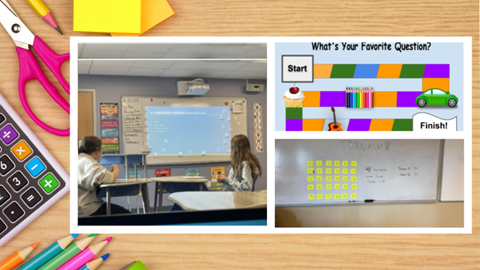
Let's face it; everyone loves to win. Everyone also enjoys fun. So why not introduce those two elements into the classroom experience with games? The magic of games in learning comes from their ability to engage, challenge, and reinforce previously taught skills and content. For this reason, they cannot be dismissed as time-wasting diversions from precious learning time. Games are not just about fun; they help teachers build connections between the rigors of learning and the satisfaction of achievement, while also reducing forgetting.
Teachers put countless hours into preparing classroom lessons and teaching new concepts. So how is it that weeks later, student assessment results demonstrate little evidence that anything has been taught? That's because students forget. For students to excel on assessments weeks or months removed from the lesson, it's important that teachers shift from short-term memory tactics and find ways to make what they teach stick. In addition to preparing well-planned engaging lessons, teachers must also consistently invest time into strengthening students’ information recall ability. Games can help with this.
With gamified learning, teachers revisit key concepts with students in a fun and interactive way, and tap into students’ memory banks. A recent cohort of Rutgers Alternate Route teachers designed low-tech classroom games aimed at stimulating student memory retention. These games use exciting and entertaining review formats to encourage information recall. Free for all to access, these games come with instructions and images for easy adaptation for all subjects and grade levels.
Read on below to browse each teacher-designed game and access instructions.
Science
Race to the Board (8th grade science)
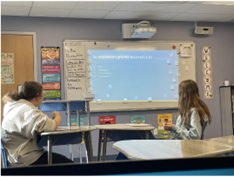
Learning about the structure of DNA, acquired versus inherited traits, and types of mutations might not sound like fun to most eighth-graders. But those in Nicole Arena's middle school science class can't get enough of these science concepts thanks to the Race to the Board game she plays with them to reinforce her lessons. Race to the Board is an engaging classroom game that promotes active learning and competition among her science students, and it can be used for any grade level or subject.
Game Objective & Instructions
In the classroom, each student receives a whiteboard. The teacher posts questions on the big board using a projector or slides created in an application like Google Slides or Microsoft PowerPoint. The students write their answers on their whiteboards. The first three whiteboards with correct answers raised in the air continue to the next step. Students then race to the front of the room, where the teacher has post-its taped to the big board. The Post-its have points on the back that are not visible when taped. At the end of the game, the students tally up their points, and the student with the most points wins. The teacher includes both negative and positive numbers on the Post-its, so students may gain or lose points, depending on their luck.
Physics Survivor (High School Physics)
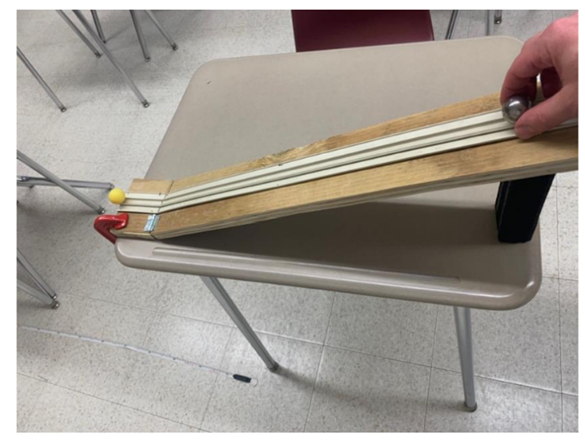
Physics Survivor, an original game developed by Peter Kapla, is an exciting challenge that takes inspiration from the popular TV show, Survivor. In this challenge, small teams of 3 or 4 students race to the finish before the bell rings. This challenge not only tests the students' knowledge and skills in physics but also encourages teamwork and critical thinking. It provides an engaging and interactive way for students to apply their understanding of physics concepts.
Game Objective & Instructions
First, each individual tackles a set of qualitative questions to demonstrate their basic proficiency in the topic. These questions are delivered through a Google Form. Next, the group must work together to solve traditional physics problems from the unit. They can call the teacher, who acts as the host, to check their work. If their answers are correct, they move forward in the challenge. Otherwise, they must return to correct their answers. Finally, the group faces a puzzle challenge in the form of an elastic collision setup. They are given an object with a known mass and another object with an unknown mass. Using measurements from the collision and applying the principle of conservation of momentum, they must infer the mass of the unknown object.
Upon completion of the group challenge, the teams are awarded immunity from section one of the quiz valued at 20 points on the unit quiz. On completion of each step (a-c) of the puzzle challenge, the team is awarded 3 points. Finally, for completing the measurements and submitting an estimate of the unknown mass the teams receive an additional 5 points. If the mass is correct within 20%, the team will earn immunity from section two of the quiz valued at 20 points on the unit quiz
Tornado! (High School Precalculus)
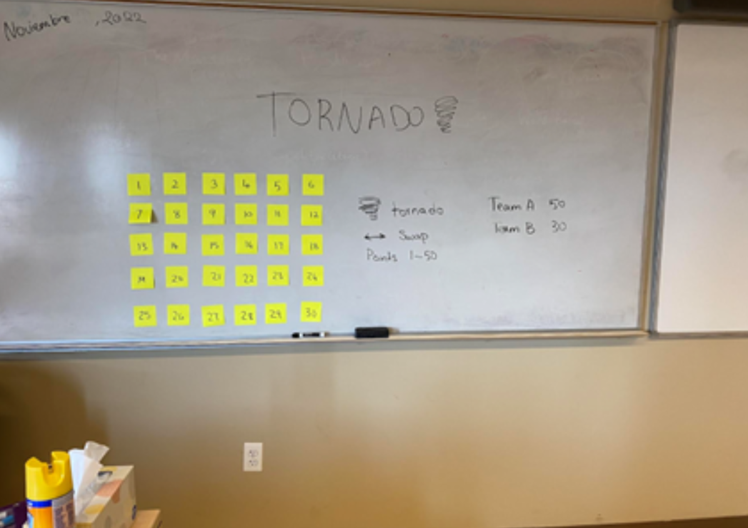
Tornado by Amira Adbelsalam is an original review game that aims to help students review the content learned during previous functions lessons. The game assumes that students have previously learned skills such as solving equations, evaluating functions, finding x and y intercepts, and graphing quadratic and linear functions. They should also know the definitions of symmetry and even/odd functions. Topics Amira addressed when she developed the game included inequalities, domain/range of functions, function analysis, function symmetry, and even/odd functions.
Game Objective & Instructions
To play the game, you will need Post-its, a Sharpie marker, and a question bank. First, develop and quiz questions, cluster similar questions under common topics, and include questions of varying difficulty levels based on Bloom's Taxonomy. Next, number the Post-it notes from 1-30. Each Post-it note should have one of the following written on it–a question along with a point value from 1-50, the word "swap," which allows a team to swap points with another team, or the word "tornado" which allows a team to wipe out another team's score. Teams take turns picking Post-it notes, and the round continues until all questions are answered. The team with the most points at the end wins.
Crumple and Shoot (High School Chemistry)

In consultation with her co-teacher Ms. Brennan, Chemistry teacher Elizabeth Szumigala created a game known as "Crumple and Shoot" to assess students' knowledge in previously learned topics. The game is played as a team-based activity through which she can gauge her students’ understanding of physical and chemical changes, density, conservation of mass, atomic theory, accuracy and precision. Of course, Crumple and Shoot can be adapted for use with other science topics. It can be used in other content areas also.
Game Objective & Instructions
To play the game, divide the class into three teams, ensuring that all team members are involved in answering the questions. The game reviews topics covered since the beginning of the year, and the winning team earns 1-point extra credit on the next test. Each slide has three questions, and teams must decide whether to answer a 1-point, 2-point, or 3-point question. All groups must attempt at least one 3-point question. To score points, a team must correctly answer the question and physically crumple the paper, shooting it into the trash can from behind the line. Questions are categorized based on Bloom's Taxonomy levels: 1-point questions focus on remembering and understanding, 2-point questions on applying and analyzing, and 3-point questions on evaluating and creating.
Mathematics
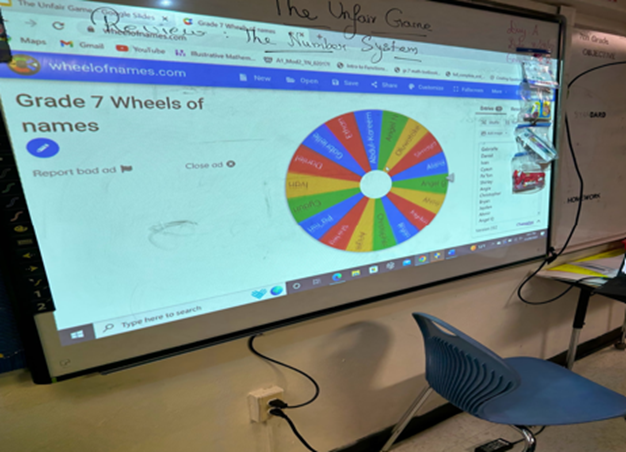
The Unfair Game (7th Grade Math)
Getting middle schoolers excited about math can be challenging. Reena Parikh realized that’s just what her seventh-grade math students needed–a challenge. That’s how the Unfair Game came to be. Reena’s Unfair Game is a review game that creates a stimulating competitive experience while helping students demonstrate their ability to work with integers, including understanding absolute values, adding, subtracting, multiplying, and dividing positive and negative numbers. The game typically last an entire period which, for Reena, runs 40-45 minutes.
Game Objective & Instructions
Prior to starting the game, be sure to have a set of math challenge questions for students to solve, a prize board with five prizes students will enjoy, and a random name selector like the one Reena uses. To play the game, the teacher posts a question on the board, and all students have 1-2 minutes to solve it at their desks. The teacher spins the wheel of names to choose a student to answer the question. If the chosen student gives the correct answer and shows their work should the question require it, they can claim one of the prizes on the prize board by writing their name next to their preferred prize. They also get a chance to spin the wheel, which they enjoy. If the chosen student gives a wrong answer, it’s the teacher who spins the wheel again to give another student an opportunity to attempt the problem.
Here’s how the game gets to be unfair. With only five prizes, at some point, all prizes will be claimed. That means as students continue to answer questions correctly, they can bump other players off the prize board by writing their name next to a preferred prize even if it’s been claimed. Students can't have their names on more than one prize line. If they win another question, they can erase another player's name for a different prize but must remove their name from the other line. At the end of the game, everyone receives a small piece of candy for participation.
What's Your Favorite Question? (Middle School Math)
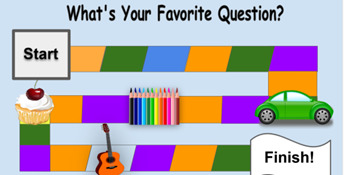
Which of the following is a statistical question? How many students are in our class? What proportion of students play sports in our class? Students in Lakia Curtis' class surely know because they have been playing What's Your Favorite Question? , a game she created to help them recognize and differentiate between statistical and non-statistical questions that anticipate variability in the data. It provides an interactive and enjoyable way for students to practice their math and listening skills while deepening their understanding of statistics. This game is targeted towards students in grades 6-7 and can be played by 2-4 players.
Game Objective & Instructions
To set up the game, the teacher displays the game board on a table or flat surface. Each player chooses a game piece and places it on the start position. The Question Cards and Challenge Cards are placed in separate piles to the side of the game board. The gameplay involves players taking turns drawing a Question Card and reading the question aloud. They must then determine if the question is statistical or non-statistical. If the player answers correctly, they move their game piece the number of spaces indicated on the card. However, if the player answers incorrectly, they must stay on the start space until their next turn. Throughout the game, landing on specific spaces triggers Challenge Cards that players must complete in order to move ahead. The game continues with players drawing cards, answering questions, and moving their game pieces until one player reaches the finish position and wins the game.
MathMoves and Ladders (Elementary Math)
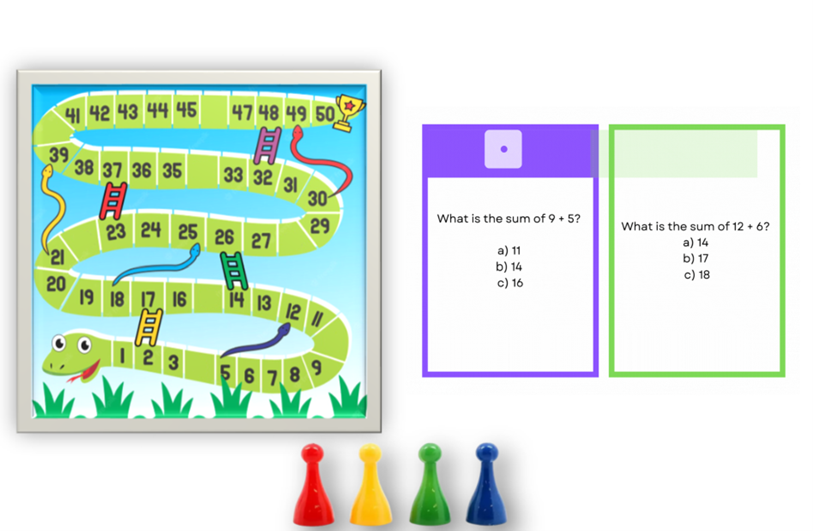
First-graders in Carlos Tapia Florentino’s class climb their way to math success with MathMoves and Ladders, a game their teacher created to reinforce their addition skills. The game incorporates various previously learned skills, including number recognition, counting, basic addition concepts, understanding of multiple-choice format, and reading comprehension.
This game is not only a fun and interactive way for young math students to practice their basic math skills but also an opportunity for them to develop important social skills such as turn-taking, good sportsmanship, and socializing with peers in a group.
Game Objective & Instructions
To set up the game, shuffle the question cards and place them question-side down in a pile. Each player chooses a different color pawn and places it on the start space, which is represented by the snake's face. The first player is determined, and the game begins. During gameplay, player one selects a card, reads the question aloud, and answers the multiple-choice question. If the answer is correct, the player moves the number of spaces shown on the card. If the answer is incorrect, the player does not move, and the card is placed question-side up in a different pile. Moving clockwise, the next player repeats the same steps. Special spaces on the board add excitement to the game. If a player lands on a blank space, they choose another card and take another turn. If they land on a snake's head, they move down to the connecting space. If they land on the bottom of a ladder, they move up to the connecting space. The game continues with players taking turns and answering questions, moving around the board until a player reaches the trophy at the finish line and wins the game.
If you’re considering following your dream of teaching, Rutgers Alternate Route can offer you the support and training you need to succeed. Be sure to follow Rutgers Alternate Route on Twitter or sign up for Alternate Route’s monthly newsletter for more information and stories from the field of education.

 DeMariah Woodard is an undergraduate student at Niagara University where she is a double major in Psychology and Criminal Justice. She supports content creation initiatives with Black Star Communications as a Digital Communications Intern for Summer 2023. Published works by DeMariah are completed in collaboration with the Rutgers Alternate Route Team and Black Star Communications.
DeMariah Woodard is an undergraduate student at Niagara University where she is a double major in Psychology and Criminal Justice. She supports content creation initiatives with Black Star Communications as a Digital Communications Intern for Summer 2023. Published works by DeMariah are completed in collaboration with the Rutgers Alternate Route Team and Black Star Communications.





